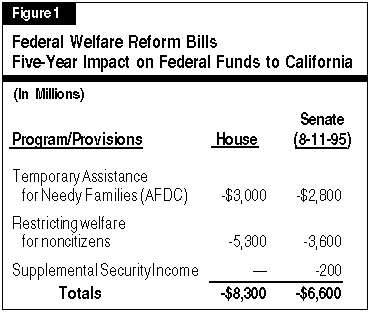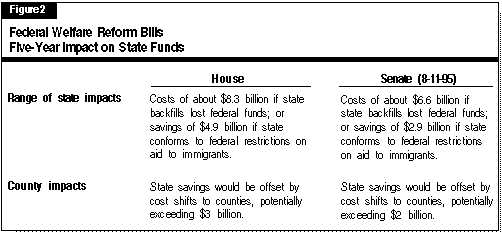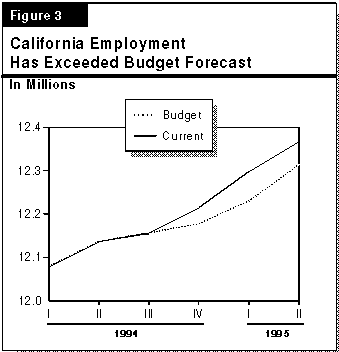

The U.S. Senate is currently debating welfare reform legislation, S. 1120--the Work Opportunity Act of 1995, introduced in August by Senate Majority Leader Bob Dole. Earlier this year, the House of Representatives passed its version of welfare reform, H.R. 4--the Personal Responsibility Act (PRA) of 1995. Both measures would make extensive changes to public assistance programs and replace them with block grants.
We have analyzed the House and Senate welfare reform proposals as they affect AFDC, Supplemental Security Income (SSI), and restrictions on welfare for noncitizens. Our analysis of S. 1120 includes amendments to that measure as proposed by Senator Dole on August 11, 1995, but does not include amendments passed during debate in early September.
Generally, the new amendments would not significantly affect our fiscal analysis. We note, however, that one of the provisions adds$3 billion over five years ($600 million per year) nationwide for child care. These funds would be provided through Title I of the act (Temporary Assistance for Needy Families), but allocated separately from the main block grant. We estimate that California would be eligible to receive up to approximately $80 million per year from this provision, depending on whether the state provided the required matching funds.
Figure 1 summarizes the effect of the selected House and Senate welfare reform provisions on federal funds allocated to California. It shows that for the House version, the net fiscal effect is estimated to be a reduction of $8.3 billion in federal funds over the first five years. For the Senate version, the five year loss is estimated to be $6.6 billion.

Figure 2 summarizes the major fiscal effects of the proposals on state/county funds.

The net effect on state/county funds depends on several variables, the most significant being:
Given these variables, the fiscal effect over five years on state/county funds could range from a cost of about $8.3 billion in the House version ($6.6 billion in the Senate version), to a savings of roughly $2 billion in the House version (roughly $1 billion in the Senate version). The costs would occur if the state chooses to backfill for the reduction in federal funds in order to maintain current service levels. The savings could result if the state does not backfill and conforms its policy to federal restrictions on eligibility of immigrants for federally funded programs.
We note that our analysis includes only the major direct fiscal effects of the proposals. Thus, some fiscal effects--such as potential state administrative savings (which would not be major compared to other fiscal effects identified) and the potentially significant indirect revenue losses that the state would experience as a result of the economic impact of the loss of federal funds--are not included.
It is clear that the Legislature will need to consider making a number of changes to state law if federal welfare reform legislation is enacted. However, the relatively modest fiscal impacts projected for 1995-96 (reduced federal funds of $18 million in the Senate bill and $71 million in the House bill) suggest that immediate legislative action would not be necessary, at least for the provisions covered in this analysis.
Contact -- Todd Bland -- (916) 445-6061
Recent reports on the California economy have been positive.
Wage and salary employment increased by 28,400 in August, with all major industries except financial services growing. About one-half of the gain was due to unusual seasonal factors. Even discounting for these factors, though, the August performance is consistent with moderate economic growth.
Recent data revisions continue to show that job creation over the past year has been greater than previously thought. Payroll employment now appears to have increased by 265,000 jobs during the past 12 months, or by more than double the growth rate indicated by the unrevised employment data.
As shown in Figure 3 (next page), the revised estimates of wage and salary employment also are well above the Department of Finance's May Revision forecast. The gain is consistent with the better-than-expected performance of personal income tax withholding throughout most of 1995.

The improvement in employment has been matched by gains in peronal income and retail spending. Personal income was up by nearly 7 percent during the first half of 1995, while taxable sales increased by about 5 percent.
The state's economic expansion has continued despite restructuring in its aerospace and financial services industries, persistent weakness in its housing sector, and a slowing in the national economy. These factors could restrain economic growth in the second half of this year. However, at present, the economic expansion continues in this state.
Total state revenue collections are up $123 million (2.3 percent) during the first two months of 1995-96. Most of this gain is due to higher personal income taxes (up $80 million) and estate taxes (up $58 million). Sales taxes have been modestly stronger than expected, while bank and corporation taxes have been somewhat weaker.
The $80 million gain in personal income taxes is primarily due to higher-than-expected withholding receipts which, as noted earlier, appear consistent with stronger employment and income. The $58 million gain in estate taxes is primarily due to one unexpected payment of $52 million in August.
September is a key revenue month with over $4.6 billion in anticipated receipts. It includes quarterly estimated income tax payments for individuals and corporations, as well as major withholding and sales tax payments.
Contact -- Brad Williams -- (916) 324-4942